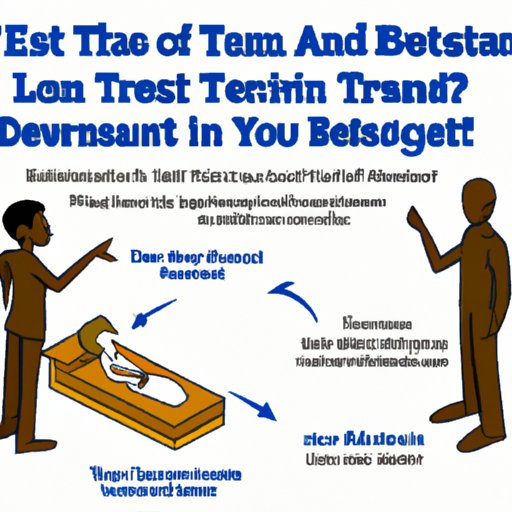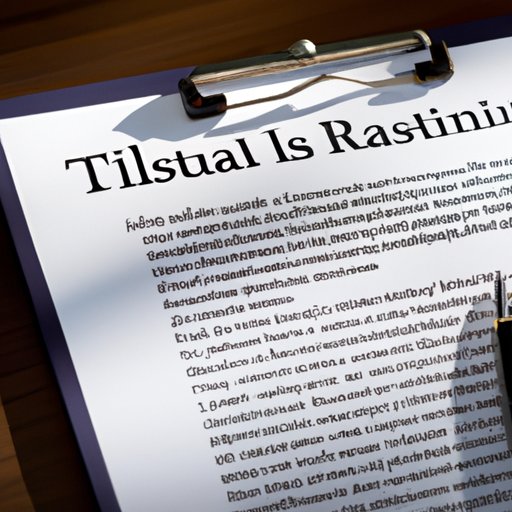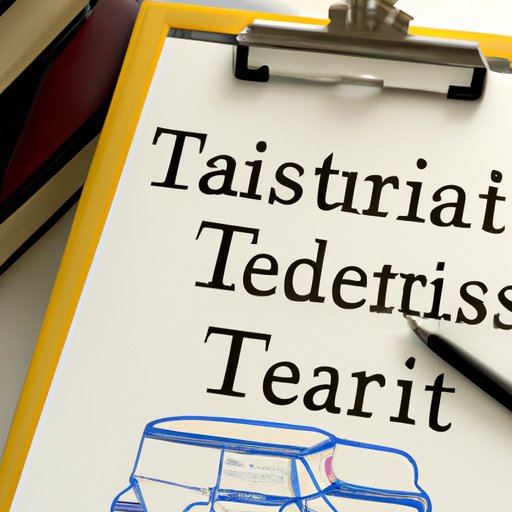Introduction
A trust is a legal arrangement in which one person (the grantor) transfers ownership of property or assets to another person (the trustee) to manage and benefit another person or group of people (the beneficiaries). It is an important tool in estate planning and can provide financial protection and privacy for the grantor’s family after they die. In this article, we will explore how a trust works after someone dies and discuss the types of trusts, the role of the executor or trustee, the benefits of creating a trust before death, and the legal requirements for establishing and administering a trust.

Explaining the Process of Setting Up a Trust Before Death and How it Works After Death
When setting up a trust, the grantor must decide what type of assets will be held in the trust. These assets may include real estate, investments, bank accounts, stocks, bonds, and other personal property. The grantor must also name a trustee, who will be responsible for managing the trust after the grantor’s death. The grantor can choose to serve as the trustee themselves or name someone else, such as a family member, friend, or professional advisor.
Once the trust has been established, the grantor can designate how the assets should be distributed after their death. The grantor can specify who will receive the assets, when they will receive them, and under what conditions. For example, the grantor may specify that the assets are to be distributed to certain beneficiaries at certain ages or upon certain events. This allows the grantor to control how the assets are used after their death.
After the grantor’s death, the trustee will be responsible for managing the trust according to the grantor’s wishes and ensuring that the assets are distributed to the designated beneficiaries. This includes collecting any income generated by the trust and ensuring that any taxes due on the trust’s assets are paid. The trustee will also be responsible for keeping records of all transactions related to the trust and providing regular reports to the beneficiaries.
Discussing the Benefits of Creating a Trust Before Death and How It Can Help Beneficiaries After Death
Establishing a trust before death can provide several benefits for the grantor and their beneficiaries. One of the most significant benefits is the potential tax savings. Depending on the type of trust, the grantor may be able to avoid estate taxes on the trust’s assets. Additionally, the trust may be able to avoid capital gains taxes if the assets are sold or transferred to the beneficiaries.
The trust may also provide financial benefits for the beneficiaries. A trust can protect the assets from creditors and provide a source of income for the beneficiaries. The trust can also help the beneficiaries manage their inheritance responsibly and prevent them from making impulsive decisions with their inheritance.
Finally, a trust can provide privacy for the grantor and their family. Since a trust is not part of the public record, it can help keep the grantor’s finances and affairs private.

Examining Different Types of Trusts and How They Are Used After Death
There are several different types of trusts that can be used after the grantor’s death. A living trust is a trust that is established while the grantor is still alive and takes effect immediately. This type of trust is often used to manage a grantor’s assets during their lifetime and can be used to transfer assets to the beneficiaries after the grantor’s death.
A testamentary trust is a trust that is created in the grantor’s will and does not take effect until after the grantor’s death. This type of trust can be used to manage the assets of a minor or disabled beneficiary or to provide for a beneficiary’s long-term care. Testamentary trusts are often used to reduce estate taxes and provide ongoing financial support for the beneficiaries.
Finally, a special needs trust is a trust that is set up to provide for the care of a disabled beneficiary. This type of trust can be used to provide financial support for a disabled beneficiary without affecting their eligibility for government benefits. Special needs trusts are typically used to ensure that the disabled beneficiary is provided for financially without sacrificing their quality of life.
Analyzing the Role of an Executor or Trustee After the Grantor’s Death
An executor or trustee plays an important role in administering a trust after the grantor’s death. The executor or trustee is responsible for carrying out the grantor’s wishes and managing the trust according to the terms of the trust document. This includes collecting any income generated by the trust, paying any taxes due on the trust’s assets, and distributing the assets to the designated beneficiaries.
The executor or trustee also has a fiduciary duty to act in the best interests of the beneficiaries. This means that the executor or trustee must make sure that the trust’s assets are managed prudently and used for the benefit of the beneficiaries. The executor or trustee must also provide regular reports to the beneficiaries and keep detailed records of all transactions related to the trust.
The role of the executor or trustee can be challenging and time-consuming. It is important that the executor or trustee understands the terms of the trust and is prepared to handle any legal or financial issues that may arise.

Outlining the Legal Requirements for Establishing a Trust and Administering it After Death
In order to establish a trust, the grantor must create a trust document that outlines the terms of the trust. This document must include the names of the grantor, the trustee, and the beneficiaries, as well as the types of assets that will be held in the trust. The grantor must also sign the document and have it witnessed by two individuals.
When administering a trust after the grantor’s death, the executor or trustee must follow certain legal requirements. This includes filing any necessary paperwork with the court, paying any taxes due on the trust’s assets, and distributing the assets to the designated beneficiaries. The executor or trustee may also need to hire a lawyer to help with any legal issues that may arise.
Conclusion
A trust can be an invaluable tool in estate planning. It can provide financial benefits, privacy, and protection for the grantor’s family after the grantor’s death. Establishing a trust before death can help ensure that the grantor’s wishes are carried out and that the assets are distributed according to their wishes. It is important to understand the types of trusts available, the role of the executor or trustee, and the legal requirements for setting up and administering a trust after death.
(Note: Is this article not meeting your expectations? Do you have knowledge or insights to share? Unlock new opportunities and expand your reach by joining our authors team. Click Registration to join us and share your expertise with our readers.)
